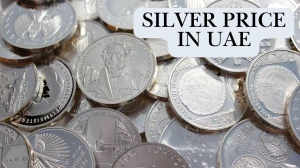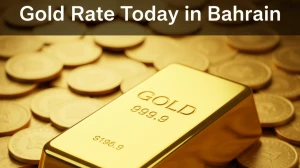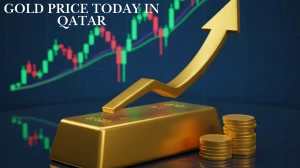
Gold Hits $4,000 Per Ounce: Historic Milestone and What It Means for Your Investment in 2025
Gold hit a historic $4,000 per ounce in October 2025, up 60% year-over-year. Expert analysis on what this means for your investments, 2026 forecasts, and whether to buy now.
by Admin
Published Oct 23, 2025 | Updated Oct 23, 2025 | 📖 25 min read
On This Page
- The $4,000 Milestone: Breaking Down the Numbers
- What's Driving Gold to Record Highs? The Five Key Forces
- Expert Forecasts: Where Is Gold Headed in 2026?
- Should You Buy Gold Now? A Practical Investment Guide
- How to Invest in Gold: 5 Different Methods Explained
- Gold Price Drivers to Watch in 2026
- Common Mistakes to Avoid When Investing in Gold
- Gold vs. Other Safe-Haven Assets: A Comparison
- The Psychology of Gold: Why $4,000 Matters
- Historical Context: How Does This Compare to Past Gold Rallies?
- Regional Perspective: How $4,000 Gold Affects Different Countries
- Environmental and Ethical Considerations
- The Future of Gold: Long-Term Outlook to 2030
- Frequently Asked Questions (FAQs)
- Conclusion: The $4,000 Milestone in Context
In a moment that financial historians will remember for decades, gold shattered through the psychological $4,000 per ounce barrier on October 8, 2025, marking the most significant milestone in the precious metal's history. The yellow metal reached an all-time high of $4,382 per troy ounce just weeks later, capping off a remarkable 60% gain from the previous year and leaving investors, economists, and everyday savers asking the same urgent question: What does this mean for my money?
As of October 23, 2025, gold trades at $4,093.05 per troy ounce—still near historic highs despite recent volatility. For context, just one year ago in October 2024, gold was trading around $2,700 per ounce. This extraordinary surge represents more than just numbers on a screen; it reflects a fundamental shift in how the world views money, risk, and the future of the global economy.
This comprehensive guide examines the forces behind gold's meteoric rise, what leading experts predict for 2026 and beyond, and most importantly, what this historic moment means for your investment portfolio, savings, and financial future.
The $4,000 Milestone: Breaking Down the Numbers
Gold's journey to $4,000 wasn't a smooth upward climb—it was a dramatic surge punctuated by record-breaking milestones:
- October 8, 2025: Gold crosses $4,000 for the first time in history
- Mid-October 2025: Price peaks at $4,382 per troy ounce (all-time high)
- Year-to-date performance: Up 26% in first half of 2025 alone
- One-year performance: Up 60.6% from October 2024
- Five-year performance: Gold has more than doubled from 2020 levels
- New all-time highs: 26 record highs set in first half of 2025
To put this in perspective: If you invested $10,000 in gold on October 23, 2024, your investment would be worth approximately $16,060 today—a gain of over $6,000 in just one year. Few asset classes can match this performance, and it's why gold has reclaimed its position as the world's premier safe-haven investment.
How Gold Compares to Other Investments in 2025
Gold's 60% one-year return dramatically outpaced most traditional investments:
- S&P 500: Up approximately 12-15% (typical year)
- 10-Year Treasury Bonds: Negative returns due to rising yields
- Real Estate: Up 5-8% on average (regional variation)
- Bitcoin: Volatile, ranging from $104K to $126K (see separate analysis)
- Silver: Up approximately 35-40% (riding gold's coattails)
Only Bitcoin has come close to matching gold's returns in 2025, though with significantly higher volatility and a dramatic 15% crash in mid-October that highlighted the risks of crypto investments.
What's Driving Gold to Record Highs? The Five Key Forces
Gold's historic surge to $4,000+ isn't random speculation—it's driven by powerful, interconnected economic and geopolitical forces that show no signs of weakening in 2026.
1. Unprecedented Central Bank Buying
Central banks worldwide are accumulating gold at a pace not seen in modern history. According to the World Gold Council's 2025 survey, an astounding 95% of 73 central banks surveyed expect to increase their gold holdings over the next 12 months.
The numbers are staggering:
- Central banks purchased over 1,000 tonnes of gold for three consecutive years (2022-2024)
- J.P. Morgan expects around 900 tonnes of central bank buying in 2025
- China has emerged as the largest buyer, diversifying away from U.S. dollar reserves
- Emerging market central banks are leading the charge, seeking to reduce dollar dependency
Why does this matter? Central banks are long-term, price-insensitive buyers. Unlike retail investors who panic during volatility, central banks buy consistently regardless of price, creating a structural floor under gold prices. When the world's most powerful financial institutions are aggressively buying an asset, individual investors take notice.
According to analysis by Torsten Slok, chief economist at Apollo Global Management, China is playing a "key role" in gold's price surge through three channels: direct central bank purchases, arbitrage trading between Shanghai and London markets, and robust household demand for physical gold.
2. Geopolitical Tensions and the "Uncertainty Premium"
The year 2025 has been marked by escalating global tensions that have investors fleeing to safety:
- U.S.-China Trade War: President Trump's 100% tariff on Chinese goods in October sent shockwaves through markets and pushed gold past $4,000
- Middle East Conflicts: Ongoing tensions remain unresolved, creating persistent uncertainty
- European Security Concerns: The Russia-Ukraine situation continues to simmer
- Dollar Weaponization Fears: Many nations are hedging against potential sanctions
J.P. Morgan notes that "geopolitical tensions—particularly between the US and China—are likely to remain elevated, contributing to a generally uncertain market environment" through 2026 and beyond.
The World Bank's analysis confirms this, stating: "Recent price increases have been driven by strong demand amid elevated policy uncertainty and intensifying geopolitical tensions."
3. Inflation Fears and Currency Devaluation
Despite central banks' best efforts, inflation remains a persistent concern in 2025:
- Core inflation in major economies remains above 3% targets
- Government debt levels have reached unprecedented peacetime highs
- Fiscal sustainability concerns are mounting across G-10 nations
- Currency devaluation fears drive investors to "hard" assets like gold
Gold has historically served as the ultimate inflation hedge. With U.S. national debt exceeding $35 trillion and deficits showing no signs of shrinking, investors are positioning for potential dollar weakness and purchasing power erosion.
4. Interest Rate Cuts and the "Opportunity Cost" Factor
The Federal Reserve has cut interest rates to a range of 4.00% to 4.25%, down from 5.25% to 5.50% in 2024, with two more cuts expected by year-end 2025.
Why does this boost gold? Gold doesn't pay interest or dividends. When interest rates are high (6-7%), investors face a real "opportunity cost" of holding gold instead of bonds. But when rates drop to 4% and inflation runs at 3%, that opportunity cost shrinks dramatically.
The combination of lower rates and persistent inflation has created what analysts call "negative real interest rates" in many economies—when inflation exceeds the interest you can earn on cash. In this environment, gold's zero yield suddenly looks attractive compared to cash that's losing 2-3% of purchasing power annually.
5. The "FOMO Effect" and Retail Investor Surge
As gold made headlines with each new record high, retail investors experienced classic "fear of missing out" (FOMO):
- Google searches for "should I buy gold" increased 340% in Q3 2025
- Gold ETF inflows reached record levels in September-October 2025
- Physical gold demand from households in China and India surged
- First-time gold investors accounted for 28% of new purchases
This retail surge created a self-reinforcing cycle: rising prices attracted attention, which brought new buyers, which pushed prices higher, attracting even more attention. While this FOMO-driven demand can be volatile, it has provided significant upward momentum to gold's 2025 rally.
Expert Forecasts: Where Is Gold Headed in 2026?
With gold already at historic highs, the trillion-dollar question is: Can it go higher? The world's top investment banks and analysts have released their 2026 forecasts, and the consensus is remarkably bullish.
Major Bank Forecasts for 2026
Bank of America: $5,000 per ounce
Bank of America lifted its 2026 outlook to $5,000 per ounce (with an average of $4,400 for the year), citing continued central bank buying and safe-haven demand. This represents an additional 22% gain from current levels.
Société Générale: $5,000 by End of 2026
The French bank's analysts predict gold will reach $5,000 by December 2026, driven by fiscal concerns and geopolitical risk premiums.
Goldman Sachs: $4,900 per ounce
Goldman Sachs Research forecasts a 6% rise through mid-2026, bringing gold to approximately $4,900. They note that structural central bank demand will support prices even if Western investor demand moderates.
Deutsche Bank: $4,000 average in 2026
A more conservative forecast, Deutsche Bank expects gold to average $4,000 throughout 2026—essentially maintaining current levels with moderate volatility.
J.P. Morgan: $4,000 by Mid-2026
J.P. Morgan predicts gold will average $3,675/oz in Q4 2025 and climb toward $4,000 by mid-2026, suggesting a potential near-term pullback before resuming gains.
Standard Chartered: $4,488 average
Standard Chartered raised its 2026 forecast to an average of $4,488/oz, citing the "structural shift" in central bank behavior.
Independent Analyst Predictions
LongForecast.com: Projects gold may reach $4,921 in early 2026, advancing to $5,871 by summer and potentially $6,571 by December 2026—the most bullish mainstream forecast available.
InvestingHaven: Targets near $4,200 for 2026, with potential for $5,000+ if geopolitical tensions escalate further.
deVere Group: Forecasts a rally to $5,000 in 2026 amid rising inflation and fiscal concerns, particularly if central banks reverse course on interest rates.
The Consensus View
Synthesizing these forecasts, the consensus suggests gold will trade in a range of $4,000 to $5,000 per ounce throughout 2026, with most major banks clustering around $4,500-$4,900. This represents potential upside of 10-22% from current levels—remarkable for an asset that has already gained 60% in the past year.
Key insight: Not a single major bank has issued a bearish forecast predicting gold below $3,500 in 2026. The debate isn't whether gold will rise—it's how much it will rise.
Should You Buy Gold Now? A Practical Investment Guide
With gold near all-time highs, many investors face a difficult decision: Is this the start of an even bigger rally, or are we at a temporary peak? Here's a balanced analysis to help you decide.
The Bull Case: Why Gold Could Go Higher
1. Central Bank Buying Won't Stop
With 95% of central banks planning to increase holdings, this structural demand provides a powerful tailwind that could persist for years.
2. Geopolitical Risks Remain Elevated
U.S.-China tensions, Middle East conflicts, and European security concerns show no signs of resolution. Each new crisis drives safe-haven demand.
3. Fiscal Sustainability Concerns Growing
Government debt levels are reaching levels that historically trigger currency crises. Gold benefits as a non-government asset.
4. Limited Supply Constraints
Unlike fiat currency, gold supply is limited. Annual mine production of ~3,000 tonnes can't keep pace with central bank demand of 900+ tonnes plus retail and institutional demand.
5. Inflation May Prove Sticky
If inflation remains above targets despite rate cuts, gold's appeal as an inflation hedge strengthens further.
The Bear Case: Risks to Consider
1. Already Up 60% in One Year
Mean reversion suggests some consolidation or pullback may be healthy and likely. Trees don't grow to the sky.
2. If Geopolitical Tensions Ease
A U.S.-China trade deal or Middle East peace breakthrough could reduce the "fear premium" in gold prices.
3. Opportunity Cost If Rates Rise
If inflation forces central banks to raise rates again, bonds become more attractive relative to zero-yielding gold.
4. Strong Dollar Scenario
Gold is priced in dollars. If the dollar strengthens significantly, gold typically faces headwinds (though central bank buying may offset this).
5. Profit-Taking After Historic Gains
Investors who bought at $2,500-$3,000 may take profits at $4,000+, creating selling pressure.
The Balanced Approach: Dollar-Cost Averaging
Rather than trying to time the market perfectly, many financial advisors recommend dollar-cost averaging into gold positions:
- Invest a fixed dollar amount monthly (e.g., $500/month) regardless of price
- Buy more when prices dip, less when prices rise
- Average out your entry price over 6-12 months
- Avoid the emotional stress of trying to "call the bottom"
Example: Instead of investing $6,000 in gold today at $4,093/oz, invest $500 per month for 12 months. If gold averages $4,200 over that period but dips to $3,800 some months and rises to $4,600 others, you'll capture a better average price than buying all at once.
Recommended Portfolio Allocation
Financial planners traditionally recommend 5-10% of a diversified portfolio in gold, though this can vary based on your situation:
- Conservative investors (nearing retirement): 5-8% in gold for stability
- Moderate investors (10-20 years to retirement): 8-12% in gold for growth and protection
- Aggressive investors (20+ years to retirement): 5-10% in gold as portfolio insurance
- High inflation concern: Up to 15-20% in gold as an inflation hedge
Important: These are general guidelines. Consult with a financial advisor about your specific situation, risk tolerance, and time horizon before making investment decisions.
How to Invest in Gold: 5 Different Methods Explained
If you've decided to add gold exposure to your portfolio, you have several options, each with distinct advantages and disadvantages.
1. Physical Gold (Coins and Bars)
How it works: Purchase actual gold coins or bars from dealers and store them securely.
Advantages:
- True ownership—no counterparty risk
- Tangible asset you can hold
- Works even in financial system breakdowns
- Privacy (no electronic trail)
Disadvantages:
- Storage and insurance costs (2-3% annually for vault storage)
- Premiums over spot price (2-10% depending on product)
- Liquidity challenges (must find buyer, verify authenticity)
- Security concerns if storing at home
Best for: Long-term holders concerned about system risk who don't need liquidity.
Current costs: A 1-ounce American Gold Eagle coin currently costs approximately $4,250-$4,350 (including ~$200-250 premium over spot).
2. Gold ETFs (Exchange-Traded Funds)
How it works: Buy shares in funds that hold physical gold, tradable like stocks.
Popular gold ETFs:
- SPDR Gold Shares (GLD) - largest, most liquid
- iShares Gold Trust (IAU) - lower expense ratio
- Aberdeen Standard Physical Gold Shares (SGOL) - stored in Switzerland
Advantages:
- High liquidity—buy/sell instantly during market hours
- Low costs (0.15-0.40% annual expense ratio)
- No storage or insurance headaches
- Can trade in retirement accounts (IRA, 401k)
Disadvantages:
- Counterparty risk (trust the fund)
- Can't take physical delivery easily
- Subject to market hours (can't trade 24/7)
- Annual expense fees erode returns slightly
Best for: Most investors seeking gold exposure with maximum liquidity and convenience.
3. Gold Mining Stocks
How it works: Buy shares in companies that mine gold, benefiting from leverage to gold prices.
Advantages:
- Leverage—mining stocks often rise 2-3x more than gold itself
- Dividend income from profitable miners
- Potential for operational improvements to boost value
- Easier to trade than physical gold
Disadvantages:
- Company-specific risks (management, accidents, costs)
- Higher volatility than gold itself
- Doesn't perfectly track gold prices
- Requires research into individual companies
Popular gold miners: Newmont Corporation (NEM), Barrick Gold (GOLD), Franco-Nevada (FNV)
Best for: Investors seeking higher potential returns and willing to accept higher volatility.
4. Gold Futures and Options
How it works: Trade contracts for future gold delivery on commodity exchanges.
Advantages:
- High leverage (control large positions with small capital)
- 24-hour trading availability
- Potential for large profits from small moves
- Can profit from falling prices (short selling)
Disadvantages:
- Extreme risk—can lose more than initial investment
- Complex—requires significant knowledge
- Time decay on options
- Not suitable for long-term buy-and-hold
Best for: Experienced traders only—not recommended for most investors.
5. Digital Gold Platforms
How it works: Apps and platforms let you buy fractional gold ownership backed by physical reserves.
Popular platforms: OneGold, Vaulted, Goldmoney
Advantages:
- Buy small amounts (even $10-50)
- No storage concerns
- Easy to start for beginners
- Can take delivery if desired
Disadvantages:
- Platform risk (what if company fails?)
- Higher fees than ETFs typically
- Less regulatory oversight than ETFs
- Newer, less proven model
Best for: Beginners wanting to start with small amounts.
Recommended Strategy for Most Investors
A balanced approach might include:
- 70-80% in gold ETFs (liquidity and low cost)
- 10-20% in physical gold coins (insurance against system risk)
- 10% in gold mining stocks (for potential leverage)
This provides diversification across gold investment types while maintaining liquidity and reasonable costs.
Gold Price Drivers to Watch in 2026
As you monitor your gold investments through 2026, keep close watch on these key indicators that will drive prices:
1. Federal Reserve Interest Rate Decisions
Watch FOMC (Federal Open Market Committee) meetings scheduled for January, March, June, September, and December 2026. Rate cuts are gold-positive; rate hikes are gold-negative.
2. U.S.-China Trade Relations
Any escalation in tariffs or sanctions will likely push gold higher. A trade deal could trigger short-term profit-taking.
3. Central Bank Gold Purchase Data
Released quarterly by the World Gold Council. If purchasing slows below 200 tonnes/quarter, it could signal weaker structural support.
4. U.S. Dollar Index (DXY)
Gold typically moves inversely to the dollar. Watch the 100-105 level—breaks above 105 are bearish for gold; breaks below 95 are very bullish.
5. Inflation Reports (CPI and PCE)
Monthly inflation data from the U.S. Bureau of Labor Statistics. Inflation above 3% supports gold; below 2% may reduce inflation-hedge demand.
6. Government Debt Levels
U.S. debt approaching $40 trillion or debt-to-GDP above 130% would be significant psychological thresholds supporting gold.
7. Geopolitical Events
Elections, conflicts, sanctions, and trade wars all create volatility. Gold tends to spike during crisis moments.
Common Mistakes to Avoid When Investing in Gold
Don't let these common errors derail your gold investment strategy:
Mistake #1: Trying to Time the Perfect Entry
Waiting for the "perfect" price often means missing the entire rally. Dollar-cost averaging removes this pressure.
Mistake #2: Over-Allocating to Gold
Gold doesn't generate income and can be volatile. Allocating more than 20% of your portfolio creates excessive concentration risk.
Mistake #3: Buying Collectible Coins at High Premiums
Rare numismatic coins can carry 50-100%+ premiums over melt value. Unless you're a collector, stick to bullion coins (Eagles, Maples, Krugerrands) with lower premiums.
Mistake #4: Neglecting Storage Costs
Professional vault storage costs 0.5-3% annually. Factor this into your expected returns when comparing to other investments.
Mistake #5: Panic Selling During Corrections
Gold can drop 10-20% during corrections even in bull markets. If you've done your research and allocated appropriately, resist panic selling.
Mistake #6: Ignoring Tax Implications
Physical gold is taxed as a collectible at up to 28% federal rate in the U.S., higher than long-term capital gains rates on stocks. Gold ETFs may have different treatment. Consult a tax advisor.
Mistake #7: Falling for "Cash for Gold" Scams
When selling, get quotes from multiple reputable dealers. "Cash for gold" shops often pay 50-70% of actual value.
Gold vs. Other Safe-Haven Assets: A Comparison
How does gold stack up against other assets investors turn to during uncertain times?
Gold vs. Bitcoin
Bitcoin advantages:
- Higher potential returns (but also higher risk)
- Easier to transfer and store digitally
- Fixed supply cap (21 million coins)
- Growing institutional adoption
Gold advantages:
- 5,000 years of proven value storage
- Much lower volatility
- No technology risk or hacking vulnerability
- Central bank and government recognition
Verdict: Gold is proven and stable; Bitcoin is speculative but with higher upside. Many investors hold both (80% gold, 20% Bitcoin in a "digital gold" allocation).
Gold vs. U.S. Treasury Bonds
Treasury advantages:
- Guaranteed income (interest payments)
- Full faith and credit of U.S. government
- Highly liquid market
- Predictable returns
Gold advantages:
- Inflation protection (bonds lose purchasing power)
- No default risk (can't go bankrupt)
- Geopolitical hedge (not tied to any government)
- Better performance when rates fall
Verdict: Bonds for income and stability; gold for inflation protection and crisis hedging. A balanced portfolio needs both.
Gold vs. Real Estate
Real Estate advantages:
- Generates rental income
- Tax benefits (depreciation, 1031 exchanges)
- Tangible asset with utility value
- Leverage available (mortgages)
Gold advantages:
- No maintenance, property taxes, or tenant issues
- Perfect liquidity (sell instantly)
- Divisible (can sell part of holdings)
- Works in crisis when real estate doesn't
Verdict: Real estate for long-term wealth building and income; gold for liquidity and crisis protection.
The Psychology of Gold: Why $4,000 Matters
Beyond the technical and fundamental factors, the $4,000 milestone carries immense psychological weight that can create self-fulfilling market dynamics.
Round Number Psychology
Humans are psychologically drawn to round numbers. $4,000 is a major psychological barrier that, once broken, changes market perception. The same phenomenon occurred at $1,000 (2009), $2,000 (2020), and $3,000 (2024). Each breakthrough brought a wave of media attention and new investor interest.
The "New Normal" Effect
Once gold has traded above $4,000 for several weeks, that price becomes the "new normal" in investors' minds. Pullbacks to $3,800-$3,900 suddenly look like "buying opportunities" rather than expensive levels.
Mainstream Media Attention
Gold hitting $4,000 generated headlines in mainstream news outlets that rarely cover commodity markets. This exposure brings gold to the attention of millions who weren't previously considering it as an investment.
Wealth Effect and FOMO
Friends, family, and colleagues who bought gold earlier and saw 60% gains create powerful "fear of missing out" in social circles. This social proof drives additional demand.
Historical Context: How Does This Compare to Past Gold Rallies?
Gold has experienced several major bull markets in modern history. Understanding these cycles provides perspective on where we might be in the current rally.
The 1970s Gold Bull Market
Period: 1971-1980
Price move: $35 to $850 (24x increase)
Drivers: Nixon closing gold window, oil crisis, double-digit inflation, Cold War tensions
Outcome: Ended in a speculative blow-off top in January 1980, followed by a 20-year bear market
The 2000s Gold Bull Market
Period: 2001-2011
Price move: $255 to $1,921 (7.5x increase)
Drivers: Dot-com crash, 9/11, Iraq War, 2008 financial crisis, quantitative easing
Outcome: Peaked in September 2011, followed by correction to $1,050 by 2015
The Current Gold Bull Market
Period: 2019-Present (2025)
Price move so far: $1,280 to $4,382 (3.4x increase)
Drivers: COVID-19, unprecedented money printing, geopolitical tensions, central bank buying, U.S.-China trade war
Current status: Still in progress, with expert forecasts calling for higher prices in 2026
What History Teaches Us
Key patterns from previous bull markets:
- Bull markets last 8-10 years on average - We're in year 6 of the current rally, suggesting potential room to run
- Corrections of 15-30% are normal even in bull markets - Don't panic during inevitable pullbacks
- Final blow-off tops involve retail mania - We're not there yet; most retail investors still don't own gold
- Bull markets end when the fundamental drivers reverse - Currently, drivers (central bank buying, geopolitical risk) remain firmly in place
Regional Perspective: How $4,000 Gold Affects Different Countries
Gold's dollar price gets the headlines, but the impact varies significantly by region based on local currencies and economic conditions.
India: The World's Largest Gold Consumer
At current exchange rates, gold at $4,093/oz translates to approximately ₹344,000 per 10 grams—near record highs in rupee terms. Despite high prices, Indian demand remains strong ahead of wedding season and Diwali celebrations. However, imports may slow if prices climb further, as many Indian buyers are price-sensitive.
China: Strategic Accumulation Continues
Chinese buyers have been instrumental in driving gold's rally through both official central bank purchases and household demand. At ¥28,800 per ounce (approximate), gold remains attractive as a hedge against property market weakness and potential yuan depreciation.
Middle East: Gold Souk Activity Surges
In Dubai, where gold trades VAT-free, the famous Gold Souk has seen robust activity despite high prices. At AED 15,033 per ounce, wealthy Gulf buyers are accumulating as a hedge against oil price volatility and regional tensions.
Europe: Currency Weakness Amplifies Gains
For European buyers, gold's gains are even more dramatic when measured in euros. At approximately €3,800 per ounce, euro-zone investors have seen 65-70% gains (versus 60% in dollar terms) due to euro weakness against the dollar.
Emerging Markets: Currency Collapse Protection
In countries experiencing currency weakness (Turkey, Argentina, Egypt), gold serves as critical protection against hyperinflation and capital controls. Local currency gold prices have soared 100-200%+ in these markets.
Environmental and Ethical Considerations
Modern gold investors increasingly consider the environmental and social impact of their investments.
Gold Mining's Environmental Footprint
- Mining one ounce of gold can generate 20 tons of mining waste
- Cyanide and mercury used in extraction pose contamination risks
- Open-pit mining destroys landscapes and ecosystems
- Carbon footprint estimated at 16-18 tons CO2 per ounce mined
Responsible Gold Initiatives
Several certifications and initiatives aim to improve gold's sustainability:
- Responsible Gold Mining Principles (World Gold Council)
- Fairmined Certification - ensures artisanal miners receive fair wages
- Conflict-Free Gold - guarantees gold doesn't fund armed conflict
- Recycled Gold - approximately 30% of annual gold supply comes from recycling
How to Invest in Ethical Gold
- Look for "Responsible Gold" certified ETFs
- Buy recycled gold coins and bars (environmentally neutral)
- Choose miners with strong ESG (Environmental, Social, Governance) ratings
- Consider gold from certified sustainable mines
The Future of Gold: Long-Term Outlook to 2030
Looking beyond 2026, what role will gold play in the evolving global financial system?
Potential Bullish Scenarios for Gold Through 2030
Scenario 1: Continued Monetary Debasement
If governments continue running large deficits and central banks maintain loose monetary policy, gold could reach $6,000-$8,000 by 2030 as currency debasement concerns intensify.
Scenario 2: New Global Monetary System
Some analysts predict a shift away from pure dollar dominance toward a multi-currency or commodity-backed system. In this scenario, gold could play an enhanced official role, potentially driving prices to $10,000+.
Scenario 3: Climate-Driven Degrowth
If climate change forces economic restructuring and reduced consumption, gold's role as a store of value independent of economic growth could strengthen significantly.
Potential Bearish Scenarios
Scenario 1: Geopolitical Stabilization
Major trade deals, peace agreements, and reduced tensions could eliminate the fear premium, returning gold to $2,500-$3,000 levels.
Scenario 2: Technology Replacement
If Bitcoin or another digital asset genuinely replaces gold's monetary functions, younger generations may abandon gold, reducing long-term demand.
Scenario 3: Asteroid Mining
Far-fetched but possible: successful asteroid mining could flood the market with precious metals, collapsing prices. Timeline: probably 2030s-2040s at earliest.
Most Likely Outcome
The consensus view suggests gold will remain a core portfolio component through 2030, trading in a broad range of $3,000-$6,000 depending on geopolitical and monetary conditions. Central bank demand provides a structural floor, while crisis moments drive periodic spikes.
Frequently Asked Questions (FAQs)
Is $4,000 gold too expensive to buy now?
Price alone doesn't determine if gold is "too expensive." What matters is the outlook and your investment horizon. Major banks forecast $4,500-$5,000 for 2026, suggesting potential upside. However, short-term corrections are possible. Dollar-cost averaging can help manage timing risk.
How high can gold realistically go in 2026?
Expert forecasts range from $4,000 (Deutsche Bank) to $5,000+ (Bank of America, Société Générale). The most common target is $4,500-$4,900, representing 10-20% upside from current levels. Extreme scenarios could see $6,000+ if geopolitical crises intensify.
Should I sell my gold now after the big rally?
This depends on your original investment thesis and time horizon. If you bought gold as a long-term hedge against inflation and geopolitical risk, those factors remain in place. If you bought purely for speculation and have hit your target, taking some profits is reasonable. Many advisors recommend rebalancing if gold exceeds 15-20% of your portfolio.
Is physical gold better than gold ETFs?
Each has advantages. Physical gold provides true ownership and works even in system breakdowns, but comes with storage costs and liquidity challenges. ETFs offer perfect liquidity and lower costs but have counterparty risk. A balanced approach might be 70-80% in ETFs for liquidity and 20-30% in physical for insurance.
Will gold crash like it did in 2011?
The 2011 crash occurred when the Federal Reserve stopped quantitative easing and the European debt crisis stabilized, removing gold's key drivers. Today's drivers (central bank buying, geopolitical risk, fiscal concerns) appear more durable. However, any asset that rises 60% can correct 20-30% even in a bull market.
How much gold should I own in my portfolio?
Traditional guidance suggests 5-10% for most investors, potentially increasing to 15-20% for those especially concerned about inflation or geopolitical risk. Your age, risk tolerance, and other holdings should guide your allocation. Consult a financial advisor for personalized advice.
Can I buy gold in my IRA or 401(k)?
Yes, through gold ETFs available in most retirement accounts. Some specialized custodians also allow "self-directed IRAs" that can hold physical gold, though this involves more complexity and fees. Check with your plan administrator about available options.
What's the difference between 22K and 24K gold for investing?
24K gold is 99.9% pure and commands the highest price. 22K gold is 91.6% pure (the rest is usually copper for durability) and is common in jewelry. For investment purposes, stick to 24K gold bars and coins or 22K bullion coins like Gold Eagles. Avoid jewelry, which includes large craftsmanship premiums.
How do I protect against fake gold?
Buy only from reputable dealers (APMEX, JM Bullion, SD Bullion, local coin shops with long track records). Stick to recognized coins (American Eagles, Canadian Maples, South African Krugerrands) that are harder to counterfeit. For large purchases, consider assay testing. Gold ETFs eliminate this concern entirely.
What happens to gold if the U.S. dollar collapses?
Gold is priced in dollars but traded globally. If the dollar weakens significantly, gold's dollar price would likely rise even more dramatically. In a true dollar collapse scenario (highly unlikely but theoretically possible), gold priced in other currencies or in terms of purchasing power would likely surge as it has during every fiat currency crisis in history.
Conclusion: The $4,000 Milestone in Context
Gold's breakthrough above $4,000 per ounce represents far more than just another price milestone. It reflects a profound shift in how the world views risk, money, and the future of the global financial system.
The forces driving gold to record highs—unprecedented central bank buying, escalating geopolitical tensions, fiscal sustainability concerns, and inflation fears—show no signs of reversing in 2026. With 95% of central banks planning to increase their gold holdings and major investment banks forecasting $4,500-$5,000 by late 2026, the bull case for gold remains compelling.
However, after a 60% one-year rally, some consolidation or correction would be normal and healthy. The question isn't whether gold will experience volatility—it will. The question is whether the long-term fundamental case remains intact, and on that measure, the evidence suggests yes.
For investors, the $4,000 milestone shouldn't trigger fear of missing out or panic about high prices. Instead, it should prompt a rational reassessment of portfolio allocation. If you have zero gold exposure and the analysis in this article resonates with your concerns about inflation, geopolitical risk, or monetary policy, consider starting a position through dollar-cost averaging.
If you already own gold and it has appreciated significantly, congratulations—but also consider rebalancing if gold now represents an outsized portion of your portfolio. The same diversification principles that led you to buy gold also suggest taking some profits if it exceeds 20% of your holdings.
Most importantly, base your decisions on your personal financial situation, risk tolerance, and investment horizon—not on headlines or short-term price movements. Gold has preserved wealth for 5,000 years not because it never declined, but because it maintained purchasing power through every crisis humanity has faced.
The $4,000 milestone will be remembered as a historic moment in financial markets. Whether it proves to be the beginning of an even larger rally toward $5,000+ or a temporary peak before consolidation will only be known with hindsight. What we can say with confidence is that gold has reclaimed its rightful place as a core portfolio holding for the 2025 investment landscape.
As always, this article is for educational purposes only and does not constitute financial advice. Consult with a qualified financial advisor before making investment decisions.
Last updated: October 23, 2025
Gold spot price as of publication: $4,093.05 per troy ounce
FAQs - Gold Hits $4,000: Investment Guide for 2025
. Is $4,000 gold too expensive to buy now?
Price alone doesn't determine if gold is too expensive. Major banks forecast $4,500-$5,000 for 2026, suggesting potential upside. What matters is the outlook and your investment horizon. Consider dollar-cost averaging to manage timing risk if you're concerned about buying at a high.
. How high can gold realistically go in 2026?
Expert forecasts range from $4,000 (Deutsche Bank) to $5,000+ (Bank of America, Société Générale). The consensus clusters around $4,500-$4,900, representing 10-20% upside from current levels. Extreme scenarios could see $6,000+ if geopolitical crises intensify.
. Should I sell my gold after it went up 60% in one year?
This depends on your original investment thesis. If you bought gold as a long-term hedge against inflation and geopolitical risk, those factors remain in place. If you bought purely for speculation, taking some profits is reasonable. Consider rebalancing if gold exceeds 15-20% of your portfolio.
. Is physical gold better than gold ETFs?
Each has advantages. Physical gold provides true ownership and works in system breakdowns, but has storage costs and liquidity challenges. ETFs offer perfect liquidity and lower costs but have counterparty risk. A balanced approach is 70-80% in ETFs for liquidity and 20-30% in physical for insurance.
. Will gold crash like it did after 2011?
The 2011 crash occurred when the Fed stopped quantitative easing and crises stabilized. Today's drivers (central bank buying, geopolitical risk, fiscal concerns) appear more durable. However, corrections of 20-30% are possible even in bull markets.
. How much gold should I own in my investment portfolio?
Traditional guidance suggests 5-10% for most investors, potentially increasing to 15-20% for those especially concerned about inflation or geopolitical risk. Your age, risk tolerance, and other holdings should guide allocation. Consult a financial advisor for personalized advice.
. Why is gold rising so much in 2025?
Five key factors are driving gold: (1) Unprecedented central bank buying (900+ tonnes annually), (2) Escalating U.S.-China trade tensions and geopolitical risks, (3) Inflation concerns and currency devaluation fears, (4) Federal Reserve interest rate cuts reducing opportunity cost, and (5) Retail investor FOMO as prices hit new records.
. Can I buy gold in my retirement account (IRA or 401k)?
Yes, most retirement accounts allow gold ETFs. Some specialized custodians offer self-directed IRAs that can hold physical gold, though this involves more complexity and fees. Check with your plan administrator about available options. Gold ETFs are the simplest way to add gold exposure to retirement accounts.




